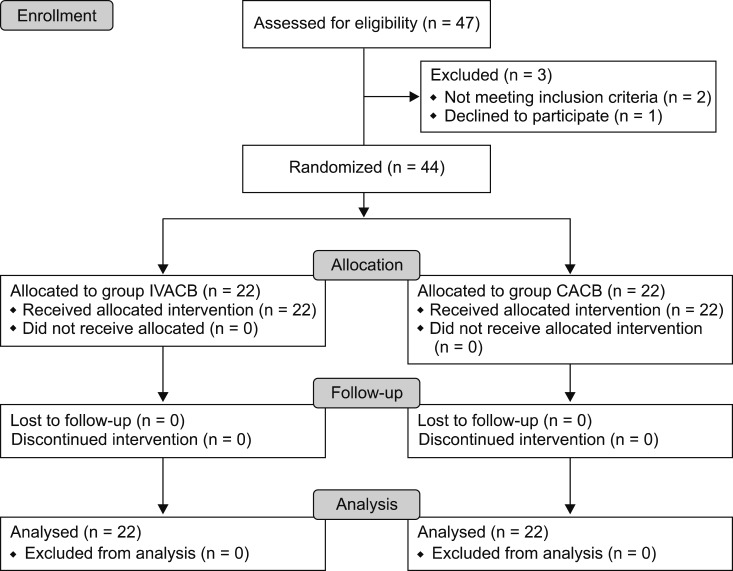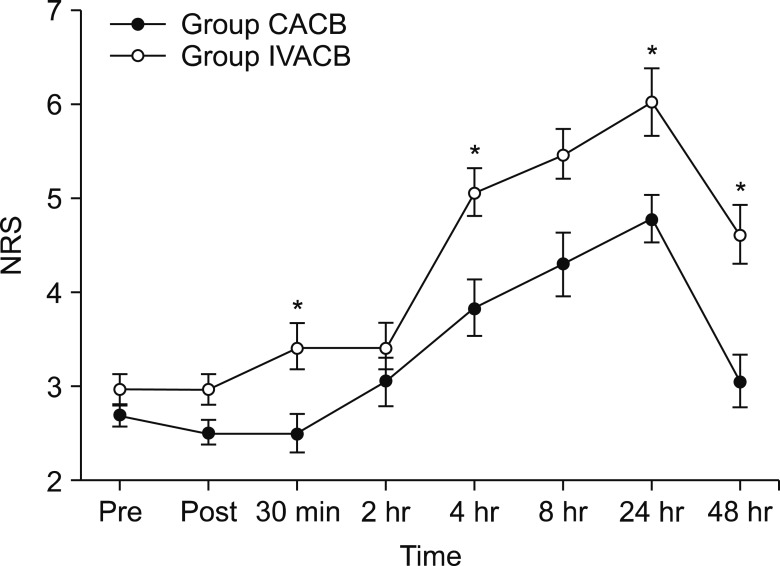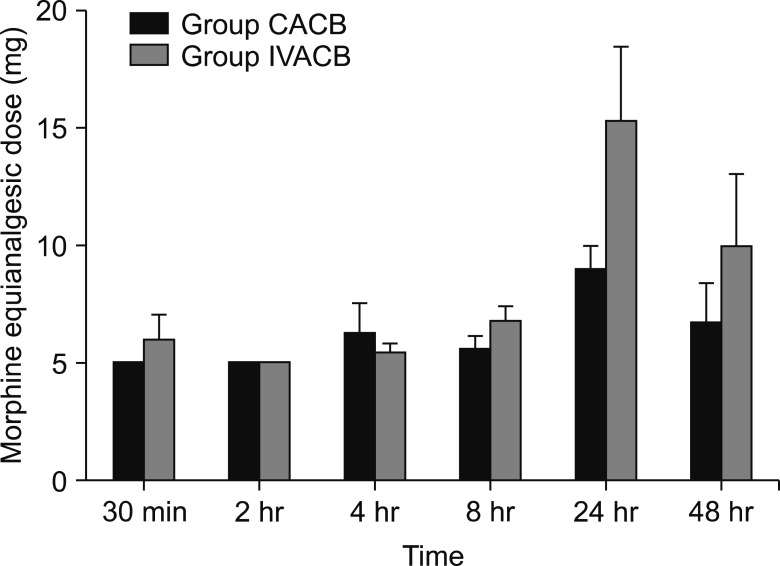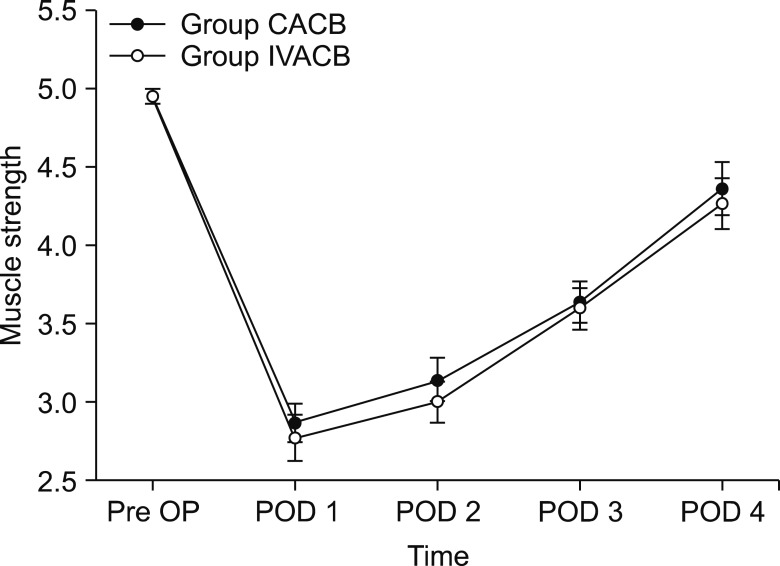Korean J Pain.
2019 Jan;32(1):30-38. 10.3344/kjp.2019.32.1.30.
The analgesic efficacy of the continuous adductor canal block compared to continuous intravenous fentanyl infusion with a single-shot adductor canal block in total knee arthroplasty: a randomized controlled trial
- Affiliations
-
- 1Department of Anesthesiology and Pain Medicine, College of Medicine, Chung-Ang University, Seoul, Korea. pain@cau.ac.kr
- 2Department of Orthopedic Surgery, College of Medicine, Chung-Ang University, Seoul, Korea.
- KMID: 2430761
- DOI: http://doi.org/10.3344/kjp.2019.32.1.30
Abstract
- BACKGROUND
The adductor canal block (ACB) is an effective intervention for postoperative analgesia following total knee arthroplasty (TKA). However, the ideal ACB regimen has not yet been established. We compared the analgesic effects between a continuous ACB group and fentanyl-based intravenous patient-controlled analgesia (IV-PCA) with a single-shot ACB group.
METHODS
Patients who underwent TKA were randomly allocated to either a continuous ACB group (Group CACB) or IV-PCA with a single-shot ACB group (Group IVACB). Before the surgery, ultrasound guided ACB with 0.5% ropivacaine 20 cc was provided to all patients. Before skin incision, the infusion system (0.2% ropivacaine through an adductor canal catheter in group CACB vs. intravenous fentanyl in group IVACB) was connected. The postoperative pain severity; the side effects of local anesthetics and opioids; administration of rescue analgesics and anti-emetics; and sensorimotor deficits were measured.
RESULTS
Postoperative pain severity was significantly higher in the IVACB group at 30 min, 4 h, 24 h, and 48 h after surgery. The averages and standard deviations (SD) of the NRS score of postoperative pain were 0.14 ± 0.37, 4.57 ± 2.37, 6.00 ± 1.63, and 4.28 ± 1.49, respectively in the IVACB group. Rescue analgesic requirements and quadriceps muscle strength were not statistically different between the groups throughout the postoperative period. Moreover, rescue antiemetic requirements were higher in group IVACB than group CACB.
CONCLUSIONS
In this study, the continuous ACB provided superior analgesia and fewer side effects without any significant motor deficit than the IV-PCA with a single-shot ACB.
Keyword
MeSH Terms
-
Analgesia
Analgesia, Patient-Controlled
Analgesics
Analgesics, Opioid
Anesthetics, Local
Antiemetics
Arthroplasty, Replacement, Knee*
Catheters
Fentanyl*
Humans
Nausea
Pain Management
Pain, Postoperative
Postoperative Period
Quadriceps Muscle
Skin
Ultrasonography
Vomiting
Analgesics
Analgesics, Opioid
Anesthetics, Local
Antiemetics
Fentanyl
Figure
Reference
-
1. Fischer HB, Simanski CJ, Sharp C, Bonnet F, Camu F, Neugebauer EA, et al. A procedure-specific systematic review and consensus recommend ations for postoperative analgesia following total knee arthroplasty. Anaesthesia. 2008; 63:1105–1123. PMID: 18627367.
Article2. Beswick AD, Wylde V, Gooberman-Hill R, Blom A, Dieppe P. What proportion of patients report long-term pain after total hip or knee replacement for osteoarthritis? A systematic review of prospective studies in unselected patients. BMJ Open. 2012; 2:e000435.
Article3. Chung MY, Kim CJ. The effect of bilateral femoral nerve block combined with intravenous patient-controlled analgesia after a bilateral total knee replacement. Korean J Pain. 2008; 21:211–216.
Article4. Jæger P, Zaric D, Fomsgaard JS, Hilsted KL, Bjerregaard J, Gyrn J, et al. Add uctor canal block versus femoral nerve block for analgesia after total knee arthroplasty: a randomized, double-blind study. Reg Anesth Pain Med. 2013; 38:526–532. PMID: 24121608.
Article5. Ilfeld BM, Duke KB, Donohue MC. The association between lower extremity continuous peripheral nerve blocks and patient falls after knee and hip arthroplasty. Anesth Analg. 2010; 111:1552–1554. PMID: 20889937.
Article6. Kim DH, Lin Y, Goytizolo EA, Kahn RL, Maalouf DB, Manohar A, et al. Adductor canal block versus femoral nerve block for total knee arthroplasty: a prospective, randomized, controlled trial. Anesthesiology. 2014; 120:540–550. PMID: 24401769.
Article7. Shah NA, Jain NP. Is continuous adductor canal block better than continuous femoral nerve block after total knee arthroplasty? Effect on ambulation ability, early functional recovery and pain control: a randomized controlled trial. J Arthroplasty. 2014; 29:2224–2229. PMID: 25041873.
Article8. Mudumbai SC, Ganaway T, Kim TE, Howard SK, Giori NJ, Shum C, et al. Can bedside patient-reported numbness predict postoperative ambulation ability for total knee arthroplasty patients with nerve block catheters? Korean J Anesthesiol. 2016; 69:32–36. PMID: 26885299.
Article9. Mizner RL, Petterson SC, Stevens JE, Vandenborne K, Snyder-Mackler L. Early quadriceps strength loss after total knee arthroplasty. The contributions of muscle atrophy and failure of voluntary muscle activation. J Bone Joint Surg Am. 2005; 87:1047–1053. PMID: 15866968.10. Ackerman DB, Trousdale RT, Bieber P, Henely J, Pagnano MW, Berry DJ. Postoperative patient falls on an orthopedic inpatient unit. J Arthroplasty. 2010; 25:10–14. PMID: 19062249.
Article11. Shah NA, Jain NP, Panchal KA. Adductor canal blockade following total knee arthroplasty-continuous or single shot technique? Role in postoperative analgesia, ambulation ability and early functional recovery: a randomized controlled trial. J Arthroplasty. 2015; 30:1476–1481. PMID: 25824025.
Article12. Burckett-St Laurant D, Peng P, Girón Arango L, Niazi AU, Chan VW, Agur A, et al. The nerves of the adductor canal and the innervation of the knee: an anatomic study. Reg Anesth Pain Med. 2016; 41:321–327. PMID: 27015545.13. Mariano ER, Kim TE, Wagner MJ, Funck N, Harrison TK, Walters T, et al. A randomized comparison of proximal and distal ultrasound-guided adductor canal catheter insertion sites for knee arthroplasty. J Ultrasound Med. 2014; 33:1653–1662. PMID: 25154949.
Article14. Compston A. Aids to the investigation of peripheral nerve injuries. Medical Research Council: Nerve Injuries Research Committee. His Majesty's Stationery Office: 1942; pp. 48 (iii) and 74 figures and 7 diagrams; with aids to the examination of the peripheral nervous system. By Michael O'Brien for the Guarantors of Brain. Saunders Elsevier: 2010; pp. [8] 64 and 94 Figures. Brain. 2010; 133:2838–2844. PMID: 20928945.
Article15. Singelyn FJ, Deyaert M, Joris D, Pendeville E, Gouverneur JM. Effects of intravenous patient-controlled analgesia with morphine, continuous epidural analgesia, and continuous three-in-one block on postoperative pain and knee rehabilitation after unilateral total knee arthroplasty. Anesth Analg. 1998; 87:88–92. PMID: 9661552.
Article16. Fowler SJ, Symons J, Sabato S, Myles PS. Epidural analgesia compared with peripheral nerve blockade after major knee surgery: a systematic review and meta-analysis of randomized trials. Br J Anaesth. 2008; 100:154–164. PMID: 18211990.
Article17. Kandasami M, Kinninmonth AW, Sarungi M, Baines J, Scott NB. Femoral nerve block for total knee replacement-a word of caution. Knee. 2009; 16:98–100. PMID: 19046884.18. Manickam B, Perlas A, Duggan E, Brull R, Chan VW, Ramlogan R. Feasibility and efficacy of ultrasound-guided block of the saphenous nerve in the adductor canal. Reg Anesth Pain Med. 2009; 34:578–580. PMID: 19916251.
Article19. Li D, Yang Z, Xie X, Zhao J, Kang P. Adductor canal block provides better performance after total knee arthroplasty compared with femoral nerve block: a systematic review and meta-analysis. Int Orthop. 2016; 40:925–933. PMID: 26452678.
Article20. Memtsoudis SG, Yoo D, Stundner O, Danninger T, Ma Y, Poultsides L, et al. Subsartorial adductor canal vs femoral nerve block for analgesia after total knee replacement. Int Orthop. 2015; 39:673–680. PMID: 25297681.
Article21. Deloach JK, Boezaart AP. Is an adductor canal block simply an indirect femoral nerve block? Anesthesiology. 2014; 121:1349–1350.
Article22. Ishiguro S, Yokochi A, Yoshioka K, Asano N, Deguchi A, Iwasaki Y, et al. Technical communication: anatomy and clinical implications of ultrasound-guided selective femoral nerve block. Anesth Analg. 2012; 115:1467–1470. PMID: 22886842.
Article23. Chen J, Lesser JB, Hadzic A, Reiss W, Resta-Flarer F. Adductor canal block can result in motor block of the quadriceps muscle. Reg Anesth Pain Med. 2014; 39:170–171. PMID: 24553306.
Article24. Gautier PE, Hadzic A, Lecoq JP, Brichant JF, Kuroda MM, Vandepitte C. Distribution of injectate and sensory-motor blockade after adductor canal block. Anesth Analg. 2016; 122:279–282. PMID: 26678473.
Article25. Joshi G, Gandhi K, Shah N, Gadsden J, Corman SL. Peripheral nerve blocks in the management of postoperative pain: challenges and opportunities. J Clin Anesth. 2016; 35:524–529. PMID: 27871587.
Article26. Holm B, Kristensen MT, Bencke J, Husted H, Kehlet H, Bandholm T. Loss of knee-extension strength is related to knee swelling after total knee arthroplasty. Arch Phys Med Rehabil. 2010; 91:1770–1776. PMID: 21044725.
Article27. Cuvillon P, Ripart J, Lalourcey L, Veyrat E, L'Hermite J, Boisson C, et al. The continuous femoral nerve block catheter for postoperative analgesia: bacterial colonization, infectious rate and adverse effects. Anesth Analg. 2001; 93:1045–1049. PMID: 11574381.
Article28. Feibel RJ, Dervin GF, Kim PR, Beaulé PE. Major complications associated with femoral nerve catheters for knee arthroplasty: a word of caution. J Arthroplasty. 2009; 24:132–137. PMID: 19553071.
Article29. Edwards JL, Pandit H, Popat MT. Perioperative analgesia: a factor in the development of heel pressure ulcers? Br J Nurs. 2006; 15:S20–S25. PMID: 16628159.
Article30. Ludwigson JL, Tillmans SD, Galgon RE, Chambers TA, Heiner JP, Schroeder KM. A comparison of single shot adductor canal block versus femoral nerve catheter for total knee arthroplasty. J Arthroplasty. 2015; 30:68–71.
Article
- Full Text Links
- Actions
-
Cited
- CITED
-
- Close
- Share
- Similar articles
-
- The relative analgesic value of a femoral nerve block versus adductor canal block following total knee arthroplasty: a randomized, controlled, double-blinded study
- Comparison of the Effect of Continuous Femoral Nerve Block and Adductor Canal Block after Primary Total Knee Arthroplasty
- Does Combination Therapy of Popliteal Sciatic Nerve Block and Adductor Canal Block Effectively Control Early Postoperative Pain after Total Knee Arthroplasty?
- Comparison of the Clinical Outcomes of a Single Injection Adductor Canal Block with the Concomitant Use of Transdermal Buprenorphine and Continuous Adductor Canal Block after Total Knee Arthroplasty
- Intravenous versus perineural dexmedetomidine as adjuvant in adductor canal block for total knee arthroplasty





